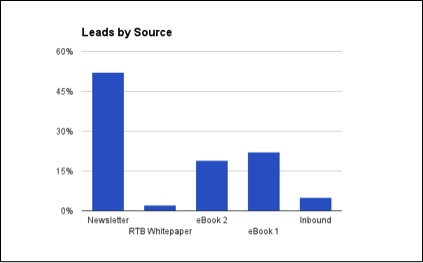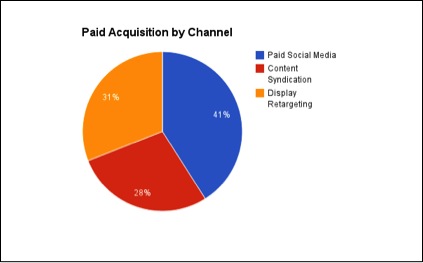In a startup, you need to gain traction fast. As the head of marketing or growth, it’s your job to deliver breakthrough results with limited resources, a small budget, no existing brand awareness, and a team that’s virtually untested.
It’s a big challenge, but you do have highly motivated people on your side with a mandate to do almost whatever it takes to win. By moving fast, being creative, taking calculated risks, and leveraging each unique opportunity to the fullest, you can succeed.
How to generate B2B sales leads
Here’s a step by step guide to develop a massively successful lead generation program in only three months, and information on how we did it:
1. Dedicate yourself to scalable digital channels
In the beginning, we tried a number of things to gain traction. We were successful with PR and events — the mainstays of B2B marketing — but the business wasn’t scaling fast enough.
After a long discussion, we agreed to dedicate ourselves to digital marketing for three reasons. First, it’s the most efficient and scalable channel; second, we had a highly technical team with the proper skills to execute in digital; and third, we wanted to focus on a single approach that enabled us to use data analysis to constantly improve.
2. Send out a CRM email every week
When ramping up digital marketing efforts, email is still one of the most cost-effective and scalable channels available to marketers. We saw it as the best way to stay in touch with our prospects and educate them about our product.
For our first email campaign, we built a list by aggregating emails from our team’s existing contacts, scouring LinkedIn, and prospecting sites such as Data.com. We managed and sent emails through a free online tool, and it worked. During the second week of the email campaign, customers we had been trying to reach for weeks emailed us back asking for sales demos!
3. Write more than 40 blog posts in six weeks
With our email program now in place, we needed lots of content. We started blogging aggressively and wrote more than 40 blog posts in just six weeks. To optimize our content as we went, we used our weekly email click-throughs as a proxy. The more relevant and interesting the content we created, the more our email click-through rates improved.
Writing these blog posts also boosted our SEO profile. Organic search traffic increased significantly, and search is now the third largest driver of traffic to our website.
4. Develop downloadable e-books
As we developed content, we discovered that downloadable content was the best way to convert users into actual leads. Our first whitepaper was a highly targeted effort that garnered a 5 percent conversion rate of high-quality leads — a great return.
Based on those results, we decided to set the bar even higher by developing a 90-page e-book that included content that would appeal to a wide range of customers. The results were amazing.
On the first day of the launch, we got hundreds of leads. The next day, hundreds more followed. Our first e-book generated nearly 800 leads.
Journalists loved it, and they published excerpts from it on blogs and websites, with links back to the e-book’s download page. This generated even more traffic.
With that foundation in place, the second e-book launch was even bigger — so big that Forbes featured it on its blog. To date, the e-book effort alone has generated thousands of leads, most from non-paid channels.
5. Advertise with sponsored updates on LinkedIn
We initially explored banner advertising but never had much success, and LinkedIn’s cost-per-thousand-impressions was too expensive for us. But when LinkedIn released its Sponsored Updates, we saw a great opportunity to get our downloadable content in front of a select group of professionals.
We tested Sponsored Updates, and it allowed us to target users based on their job titles, functions, and regions, and the data was extremely accurate. The other added benefit was that LinkedIn’s cost-per-click pricing was much lower than Google AdWords’ pricing. LinkedIn still consistently drives our highest-value leads.
6. Use retargeting to capitalize on website traffic
Driving users to a site is only part of the battle. While tools like social media and content syndication make it easy to increase site traffic, the conversion rates of those channels are low.
Retargeting with banner ads allowed us to keep our offering top of mind as users surfed the web and brought a large portion of those users back to our site, many of whom later converted to leads.
For our e-book launches, we swapped out all of the creative and drove everyone directly to our e-book download page, which resulted in significant ROI and added incrementally to our lead generation efforts.
Campaign insights
This campaign delivered data that showcased the value of spreading our efforts across several digital areas:
- Inbound leads converted to sales at the highest rate.
- Forty-eight percent of all leads generated were high-quality.
- Leads converted to sales 30-plus days after capture.
- Improving website design was the single largest contributor to increasing sales conversions.
- Improving content quality was the single largest contributor to increasing lead capture volume.
A breakout of leads by source
While inbound leads were the second lowest category by volume, they represented the highest sales conversion rate. We categorized 48 percent of all leads as high-quality, which is significantly higher than what I have seen in the past.
It’s also important to note that the conversions to sales happened at least 30 days after lead capture.
A breakout of spend by channel
In terms of ad spend, paid social has become our largest channel. We split the rest of the budget between display retargeting and content syndication.
We estimate that paid acquisition represented 35 percent of leads acquired. Organic, PR, and email drove the rest. With so many leads coming from organic search, our cost-per-lead remained significantly below our goal.
When first launching a business with few resources at your disposal, digital marketing is by far the most effective, scalable method to generate leads. Our efforts were fueled by aggressive inbound marketing and highly targeted paid media, and we were able to use data to continually inform our efforts and improve our ROI. If you’re launching a startup, consider using digital media to kick-start your lead generation machine.
Rethinking your workspace?












